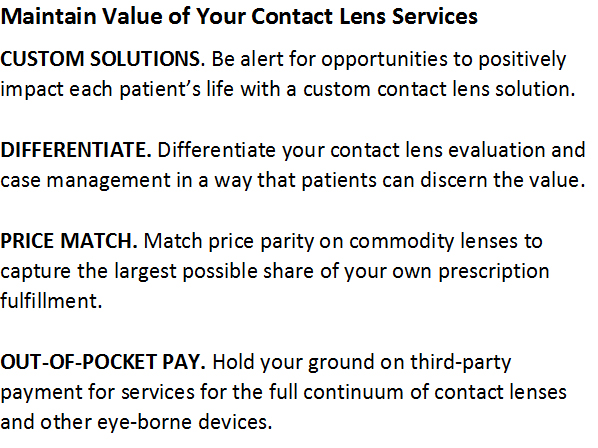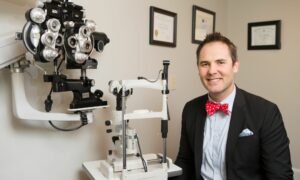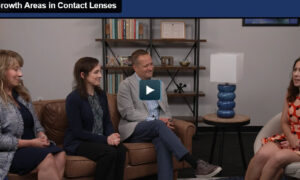By Jerome A. Legerton, OD, MS, MBA, FAAO

Feb. 28, 2018
Contact lens fees are not what they used to be. There are many reasons for this, but, fortunately, there also are strategies to maintain the profitability of contact lens services and products in our practices.
I was speaking recently with a group of optometrists about what has happened to the economics of contact lenses over the last three decades. I shared my fees when I started in practice 50 years ago. I remember them well, and recall that they represented the middle of the road for 1968.
I shared that my exam fee was $15, single-vision spectacle lenses were $15 and the average frame was $15. I charged $225 per case for contact lenses, which included services and materials. My lens cost was between $9 and $12 per pair. The only lenses available at that time were PMMA rigid lenses. So, my gross margin was about $215 per patient.
We then pulled up the Dollar Times application that computes the present-day buying power of a dollar amount in prior years. We found that $225 in 1968 computes to $1,602.42 in 2017 dollars.1
The room went quiet, and the elephant in the room was the awareness of total fees and gross margins today. Fifty years ago, 100 percent of contact lenses were made to order. Today custom lenses comprise a modestly growing 10 percent. That means that the vast majority of contact lenses are production lenses that are available through fulfillment businesses. The fulfillment channel initiates the force for what is called price parity. It is very difficult to garner higher revenue than what the floor price allows.
 A quick search online shows a general floor at $30 for a 6 lenses box cost to the patient.2, 3 A two-week replacement then requires 8 boxes for round numbers or $240 per year. Let’s say you can purchase these lenses for $15 per box, which provides a gross margin of $120 per year per patient. Keep in mind that $120 2017 dollars is equivalent in buying power to $14.04 in 1968 dollars.
A quick search online shows a general floor at $30 for a 6 lenses box cost to the patient.2, 3 A two-week replacement then requires 8 boxes for round numbers or $240 per year. Let’s say you can purchase these lenses for $15 per box, which provides a gross margin of $120 per year per patient. Keep in mind that $120 2017 dollars is equivalent in buying power to $14.04 in 1968 dollars.
The wild card is that you don’t fulfill 100 percent of your prescriptions, so your average margin per patient per year is actually lower. Multiply the percent of your patients who buy a year supply by $120, and you can estimate your average gross margin per patient.
Now, let’s be fair. You charge a contact lens exam fee in addition to your comprehensive exam fee (when you can).4 Let’s say you charge $100 for your contact lens exam and your gross margins on the year supply of lenses is $120 as shared above. That provides a total of $220 for the patients who you dispense the full complement of the year supply of lenses. This computes to $30.89 in 1968 dollars. That is if you charge a contact lens exam fee and IF you fulfill your own contact lens prescription. After the two ifs the average practitioner is earning one seventh of what we earned 50 years ago when they fit a patient with contact lenses.
The Impact of Soft Contact Lenses
Soft contact lenses ushered in an era of easier fitting. Our chair time was higher with PMMA lenses, and the gross margin per hour should be calculated to be fair. Then again, gas permeable rigid lenses allowed us to enjoy a significantly higher fee than PMMA lenses, and they took less time because oxygen transmissibility meant less case management to reduce edema.
The easier fitting of soft lenses resulted in discounting and price competition for those whose business objective was high-volume fitting. The manufacturers implemented tiered pricing based on volume, so the high-volume fitters enjoyed a lower price per lens. The volume pricing paradigm persisted when disposable lenses emerged 30 years ago. Practice procedures and policies also changed with disposable lenses. Chair time was reduced when practitioners stopped inspecting lenses and when they eliminated the per lens dispensing visits. The average fitting fee per patient went to the floor.
The performance of manufacturers was brilliant. Materials and process engineering allowed for making better lenses at a far reduced cost of goods and cost to serve. The end result is that the manufacturers of low-cost-cast-molded lenses now enjoy the gross margin in contact lenses while the practitioners, who once enjoyed the gross margin, are compromised. Note that manufacturers never asked us to lower our fees for lenses or our services to fit them. Competitive forces within our piece of the supply chain stimulated us to do it to ourselves.
Differentiate Your Services
I am a champion of differentiation whenever it is practical. The greatest lever to putting value back into our contact lens services is to treat each patient as a unique individual. This starts with case history. Consider asking the patient what they didn’t like about the care they last received, even if it was from you. Ask them what they don’t like about their glasses or contact lenses. Ask them what aspect of their vision and method of correction they would like to be different. Ask them about the number of comfortable hours they wear their lenses and the total number of hours they wear their lenses. All of these questions allow a gap analysis. The differentiation opportunity resides in the gap.
Our industry is rich with tools to help you differentiate. Consider the value of specialty lens opportunities, including hybrid lenses, scleral lenses, corneal refractive therapy, refractive error regulation (myopia control) and custom soft lenses.
I forecast significant growth in all of these over the next five years. Be open to contact lens fitting technology that will assist you in prescribing the best commodity lens for each patient. We are entering the era of managed “edge strain.”5 Ocular contour measurement will be one of the drivers for technology-driven custom lens prescribing.
The continuing evolution of technology means we’ll have ever-greater opportunities to differentiate ourselves from competitors, benefiting both patients and our bottom lines.
References
1. https://www.dollartimes.com/inflation/inflation.php?amount=100&year=1968
2. https://abbconcise.learn.com/files/pdf/SRPM.pdf
3. https://www.coastal.com/contactlenses?12-15-clhp-COM#contactLensTypeFilters=[Weeklies|SingleVisionContacts]&sorting=featuredAnywhere-asc&page=1&searchFamily=contacts&categoryCode=Contacts&filterGroup=contactLensType&pdi_contactLensType=[dailies]&widgetExpanded=false&perfectFitExpanded=false&requestIdentifier=456329&hotSpotsEnabled=true&order=[Weeklies|SingleVisionContacts]
 Jerome A. Legerton, OD, MS, MBA, FAAO, is co-founder and chief clinical and regulatory officer with Innovega Inc. He is the co-founder of SynergEyes Inc and co-inventor of Paragon CRT. Dr. Legerton was the managing partner of a seven-doctor, four office, multi-specialty practice in San Diego. He holds 54 issued U.S. patents, and has 70 pending applications. Products flowing from these patents are registered in more than 45 countries and enabled eyecare practitioners to earn more than $1 billion in fees for services and lenses in the last 15 years. Contact : jlegerton@aol.com.
Jerome A. Legerton, OD, MS, MBA, FAAO, is co-founder and chief clinical and regulatory officer with Innovega Inc. He is the co-founder of SynergEyes Inc and co-inventor of Paragon CRT. Dr. Legerton was the managing partner of a seven-doctor, four office, multi-specialty practice in San Diego. He holds 54 issued U.S. patents, and has 70 pending applications. Products flowing from these patents are registered in more than 45 countries and enabled eyecare practitioners to earn more than $1 billion in fees for services and lenses in the last 15 years. Contact : jlegerton@aol.com.

























